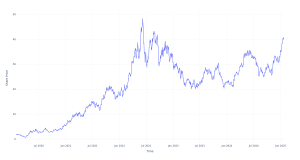In just three and a half months, the Dollar Index (DXY), which measures the value of the greenback relative to a basket of six major foreign currencies, including the euro, Japanese yen, British pound, Canadian dollar, Swedish krona, and Swiss franc, was up more than 10% (from 27 September low to 13 January high). On 13 January, it breached the critical 110.00 level and although it has since declined slightly, it remains by far the best-performing currency among other major currencies this year so far.
‘The reasons for such an impressive rally are plentiful and diverse, but generally it all boils down to the widening interest rate differentials between the United States and other major economies’, says Kar Yong Ang, a financial market analyst at Octa Broker. Indeed, the Federal Reserve (Fed), the U.S. central bank, currently maintains its benchmark interest rate in the range of 4.25-4.50%, which is the second highest level among eight industrialized economies.
Most importantly, however, unlike most other central banks, the Fed is not expected to cut the rates aggressively in 2025 as the U.S. economy continues to demonstrate striking resilience, marked by robust labour market data and strong consumer spending. In addition, geopolitical uncertainty and the risk of trade wars have fuelled safe-haven demand for the U.S. dollar. In fact, the election of Donald Trump as the next U.S. president largely served as a catalyst for the recent rally in the U.S. dollar.
‘It was always assumed that Donald Trump’s victory in the presidential race would be bullish for the U.S. dollar as his trade and immigration policies were viewed as inflationary. Therefore, the market started to price in that outcome well in advance and the dollar began its ascent one month before the election’, says Kar Yong Ang, a financial market analyst at Octa Broker.
Specifically, Trump has explicitly threatened to impose trade tariffs on Eurozone[1] and Canada[2], which clearly had a bearish impact on their currencies. For example, the Euro, which has a dominant 58% weight in the DXY, has lost more than 8% against the U.S. dollar since 25 September 2024. The biggest losers, however, have been risk-sensitive currencies such as the Australian dollar (AUD) and the New Zealand dollar (NZD) (see the chart below) both of which devalued by more than 10%.
Major Currencies Performance Since October 2024
To put it simply, the U.S. dollar is rising because of fear that Trump’s policies might spur inflation at best and trigger an all-out trade war at worst. In addition, the U.S. economy is outperforming most of its peers so the Fed is highly likely to ease its monetary policy at a much slower pace compared to other countries. Indeed, a recent Bloomberg survey forecasts a modest 1% growth for the Euro Area this year, slightly better than the 0.8% projected for 2024 but well below the long-term average of 1.4%.



